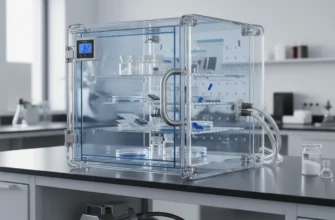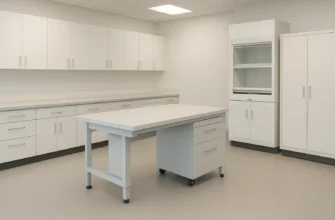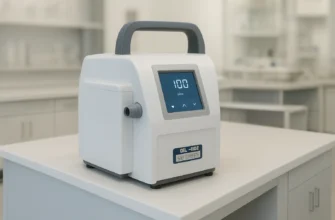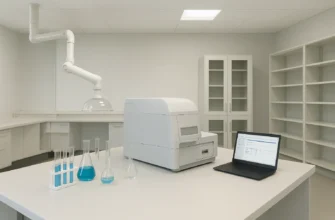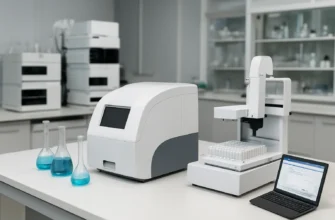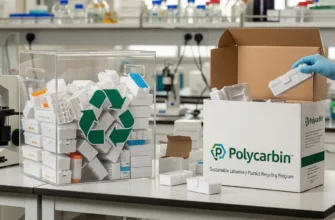Enhance Your Lab with a Quality Lab Bench Table Today
Key Highlights
Choosing a high-quality lab bench table is crucial for lab safety, efficiency, and productivity. Modern laboratory workbenches must meet rigorous standards for durability, chemical resistance, and ergonomic design to support diverse scientific applications.
-
Key features include durability, load capacity, and chemical resistance tailored to specific work surfaces and laboratory environments
-
Materials like epoxy resin, stainless steel, and phenolic resin offer unique benefits for various applications, ensuring your lab furniture meets rigorous industrial standards
-
Adjustable height designs improve ergonomics and user comfort, reducing strain during long work sessions
-
Customization options allow tailoring laboratory furniture to specific workflow and safety requirements
-
Proper space planning ensures optimal workflow and maximizes laboratory efficiency
Introduction
A lab bench table serves as the foundation for scientific discovery and research excellence. More than just laboratory furniture, it’s the central hub that supports critical experiments, houses essential equipment, and facilitates collaboration among research teams. The right lab bench can transform your laboratory’s safety profile, workflow efficiency, and overall productivity.
Whether conducting complex analytical procedures or routine testing, your choice of laboratory workbench plays a pivotal role in research outcomes. Modern lab environments demand furniture that adapts to evolving technologies while maintaining the highest safety and performance standards.
Understanding the Role of Lab Bench Tables in Modern Laboratories
Contemporary laboratory benches serve as sophisticated workstations designed to accommodate a wide range of scientific applications. They provide stable, reliable surfaces for everything from precision measurements to heavy-duty equipment installations, with each design tailored to support specific research activities and safety requirements.
Modern labs require furniture that can adapt to changing research needs, accommodate new technologies, and support collaborative workflows. The type of laboratory work you conduct determines the specific bench requirements, from chemical resistance levels to load-bearing capacity and specialized features like vibration isolation.
Understanding your laboratory’s unique demands is essential for selecting the optimal bench configuration. Consider factors such as the chemicals used, equipment weight requirements, and workflow patterns when evaluating different lab bench options.
Why Every Lab Needs a High-Quality Bench
Investing in a premium laboratory workbench is one of the most critical decisions for any research facility. High-quality benches are engineered for exceptional stability, intelligent design, and versatility across countless applications, ensuring both personnel safety and research accuracy.
Quality lab benches offer superior load-bearing strength, with capacities ranging from 400 kg for standard applications to over 2,000 kg for heavy-duty industrial use. Modern designs incorporate systematic separation of utilities and furniture, allowing for clean, organized, and efficient laboratory environments.
The durability of premium benches ensures they withstand daily laboratory rigors, from supporting heavy analytical instruments to resisting chemical spills and thermal stress. This reliability eliminates concerns about furniture limitations affecting research quality or safety.
Common Applications Across Laboratory Types
Lab benches serve diverse purposes across different research environments, with specific designs optimized for particular applications and safety requirements:
Industrial Laboratories
-
Quality control testing and materials analysis
-
Product development and manufacturing support
-
Heavy machinery support with load capacities up to 2,000 kg
Academic Laboratories
-
Educational experiments and student research projects
-
Flexible configurations for multidisciplinary activities
-
Cost-effective solutions with standard dimensions
Clinical and Medical Laboratories
-
Sample processing and diagnostic testing
-
Sterile surface requirements with antimicrobial properties
-
Compliance with biosafety and contamination control standards
Essential Features for Quality Lab Bench Tables
When selecting laboratory furniture, focus on key characteristics that impact longevity, safety, and functionality. A high-quality lab bench must demonstrate proven durability, appropriate chemical resistance, and ergonomic design to support both current and future laboratory needs.
Durability and Load Capacity
Durability represents a non-negotiable feature for laboratory workbenches, especially in demanding research environments. Your laboratory furniture must withstand daily exposure to various substances, temperature fluctuations, and the substantial weight of modern scientific equipment.
Load capacity specifications vary significantly based on application requirements:
-
Standard benches: 400-750 kg evenly distributed load
-
Heavy-duty models: 1,000-2,000 kg capacity for industrial applications
-
Specialized tables: Up to 2,500 kg for precision equipment support
The strength comes from precision-engineered steel frames with reinforced cross-sections and powder-coated finishes for corrosion resistance. Always consider the heaviest equipment you plan to install to ensure adequate load capacity without structural compromise.
Chemical and Heat Resistance
Laboratory work surfaces face constant exposure to corrosive chemicals, elevated temperatures, and moisture, making chemical and heat resistance vital safety features. Selecting appropriate worktop materials prevents surface degradation, staining, and potential safety hazards over time.
Different materials offer varying resistance levels:
-
Epoxy resin: Exceptional chemical resistance, heat tolerance up to 350°F (177°C)
-
Phenolic resin: Good chemical resistance, heat tolerance up to 570-662°F
-
Stainless steel: Excellent heat and moisture resistance, superior cleanability
Critical features ensuring optimal resistance include:
-
Non-porous surfaces preventing liquid and chemical absorption
-
Seamless construction eliminating contamination harboring joints
-
Specialized coatings enhancing protective properties
-
Material composition matched to specific hazard profiles
Adjustable Height and Ergonomic Design
Ergonomic considerations have become paramount in modern laboratory design, addressing the physical demands of extended research sessions. Adjustable height lab benches represent an innovative solution promoting user comfort while reducing musculoskeletal injury risks.
Contemporary adjustable benches offer height ranges of 630-1,030 mm with precise incremental adjustments. This flexibility accommodates multiple users and supports both sitting and standing work positions, significantly improving workplace comfort and productivity.
Ergonomic benefits include:
-
Improved posture reducing strain and fatigue
-
Enhanced productivity through comfortable working conditions
-
Reduced injury risk from repetitive motions and awkward positions
-
User adaptability accommodating diverse physical requirements
Exploring Materials for Durable Lab Bench Tables
Material selection represents the most critical decision affecting laboratory bench performance, safety, and longevity. Each material offers distinct properties tailored to specific laboratory applications, from basic educational use to demanding industrial environments.
Understanding material characteristics helps match bench selection to laboratory requirements, ensuring optimal performance and cost-effectiveness.
Epoxy Resin and Phenolic Resin Worktops
Epoxy resin stands as the gold standard for chemical laboratory applications, offering exceptional resistance to harsh chemicals, heat, and mechanical wear. This material forms through curing resin and hardener mixtures into solid, non-porous surfaces with outstanding durability.
Phenolic resin provides a cost-effective alternative with good chemical resistance and lighter weight compared to epoxy. Made by layering paper or fabric with phenolic resin under heat and pressure, it offers reliable performance for moderate-use applications.
| Feature | Phenolic Resin | Epoxy Resin |
|---|---|---|
| Chemical Resistance | Good resistance to most laboratory chemicals | Exceptional resistance to wide range of chemicals |
| Heat Resistance | Up to 570-662°F (299-350°C) | Up to 350°F (177°C) continuous use |
| Durability | Moderate scratch and impact resistance | Superior mechanical wear resistance |
| Cost | More economical option | Higher initial investment |
| Weight | Lightweight for easier handling | Heavy, requires professional installation |
| Ideal Applications | Educational labs, moderate chemical exposure | Industrial labs, demanding chemical environments |
Stainless Steel and Metal Options
Stainless steel excels in applications requiring superior cleanability, sterility, and moisture resistance. This material proves ideal for pharmaceutical labs, clinical environments, and food science applications where contamination control is paramount.
Grade 304 stainless steel represents the standard choice for most laboratory applications, offering excellent corrosion resistance and durability. For more demanding environments, Grade 316 stainless steel provides enhanced chemical resistance, particularly against chlorides and acidic solutions.
Key advantages include:
-
Superior hygienic properties with antimicrobial characteristics
-
Easy decontamination supporting sterile work environments
-
High heat resistance suitable for autoclave sterilization
-
Long-term durability with minimal maintenance requirements
However, stainless steel has limitations, including susceptibility to scratching and potential damage from certain chemicals like chlorine compounds and strong acids.
Alternative Surface Materials
Several specialized materials address specific laboratory requirements beyond standard resin and steel options:
High-Pressure Laminate (HPL) offers an economical solution for educational laboratories and dry environments. While limited in chemical resistance, HPL provides good durability and aesthetic options for basic applications.
Electrostatic Dissipative (ESD) surfaces prevent static buildup that could damage sensitive electronic components. These specialized laminates incorporate conductive layers maintaining safe static levels for electronics work.
Ceramic and stone surfaces provide exceptional heat resistance and chemical inertness but require careful handling due to brittleness. These materials suit specialized high-temperature applications despite higher costs and installation complexity.
Choosing the Right Size Lab Bench Table
Proper sizing ensures optimal laboratory workflow, safety compliance, and space utilization. An appropriately sized bench maximizes productivity while maintaining required clearances for safe operation and emergency egress.
Standard Laboratory Bench Dimensions
Standard lab bench dimensions follow established guidelines optimized for ergonomics and functionality:
Height specifications:
-
Standard working height: 85-95 cm (33-37 inches)
-
Seated work positions: 75 cm (29.5 inches)
-
Heavy-duty applications: 90 cm (35.4 inches)
Depth requirements:
-
Standard depth: 60-75 cm (24-30 inches)
-
Deep benches: 75-90 cm (30-36 inches) for large equipment
-
Compact applications: 60 cm (24 inches) minimum
Length options:
-
Single workstations: 120-180 cm (4-6 feet)
-
Standard lengths: 150 cm, 180 cm, 240 cm
-
Custom lengths: Available for specific applications
Space Planning and Clearance Requirements
Minimum clearance requirements ensure safe laboratory operation and regulatory compliance:
-
Aisle clearances: Minimum 60 cm (24 inches), preferred 90 cm (36 inches)
-
Emergency egress: 90 cm (36 inches) minimum width for main aisles
-
Workstation spacing: 150 cm (5 feet) minimum between adjacent benches
-
Equipment access: Adequate space for maintenance and cleaning
Laboratory design guidelines recommend modular planning with 11-foot (335 cm) bay widths to accommodate standard equipment and maintain proper clearances. This dimension supports 36-inch fume hoods, 60-inch aisles, and 30-inch deep benches within a single bay.
Custom vs. Standard Sizing
Standard sizes offer cost advantages and shorter lead times, making them suitable for conventional laboratory layouts and budget-conscious projects. Standard dimensions are optimized for material efficiency and common equipment requirements.
Custom dimensions provide maximum flexibility for unique spaces, specialized equipment, or specific workflow requirements. While involving higher costs and longer delivery times, custom sizing maximizes space utilization and operational efficiency.
Decision factors include:
-
Budget constraints favoring standard solutions
-
Timeline requirements for project completion
-
Space optimization needs for non-standard layouts
-
Future adaptability requirements for changing needs
Specialized Lab Bench Designs for Different Applications
Different laboratory types require specialized bench designs addressing specific operational needs, safety requirements, and performance criteria. Understanding these specialized applications ensures optimal bench selection for your laboratory environment.
Wet Lab Bench Designs
Wet laboratories handle liquids, chemicals, and biological materials, requiring benches designed for chemical exposure and frequent cleaning. These environments demand surfaces that resist degradation while supporting rigorous decontamination protocols.
Essential wet lab features include:
-
Chemical-resistant surfaces like epoxy resin or stainless steel
-
Marine edges (raised perimeters) containing spills and preventing floor contamination
-
Integrated sinks for convenient washing and waste disposal
-
Seamless construction eliminating contamination harboring areas
-
Non-porous materials preventing chemical absorption and bacterial growth
Material recommendations:
-
Epoxy resin: Superior chemical resistance for demanding applications
-
Stainless steel: Excellent for sterile environments requiring frequent sanitization
-
Phenolic resin: Cost-effective option for moderate chemical exposure
Dry Lab Benches for Electronics and Analytical Work
Dry laboratories focus on computational work, electronics, and analytical tasks requiring different performance characteristics than wet labs. These environments prioritize static control, vibration isolation, and equipment support over chemical resistance.
Specialized dry lab requirements:
-
ESD surfaces preventing static discharge damage to sensitive components
-
Vibration isolation for precision instruments and measurements
-
Integrated power and data ports supporting electronic equipment
-
Stable surfaces minimizing mechanical interference
-
Adjustable height options accommodating various tasks and users
Anti-vibration tables provide:
-
Pneumatic isolation systems reducing transmitted vibrations
-
Active vibration control with real-time adjustment capabilities
-
Passive dampening materials absorbing environmental disturbances
-
Frequency isolation in critical 1-50 Hz range
Vibration Isolation Tables for Precision Instruments
Precision instrumentation requires specialized vibration isolation to maintain measurement accuracy and equipment performance. Even minor vibrations from building systems, foot traffic, or nearby equipment can compromise sensitive analytical results.
Advanced isolation systems feature:
-
Active isolation with electronic feedback systems
-
Pneumatic support providing low natural frequencies (1.0-2.3 Hz)
-
Horizontal and vertical isolation addressing multi-directional disturbances
-
High load capacity supporting equipment up to 2,500 kg
-
Self-leveling capabilities maintaining consistent working height
Applications requiring vibration isolation include:
-
Analytical balances and precision weighing
-
Electron microscopy and advanced imaging
-
Optical measurements and interferometry
-
Surface analysis and metrology equipment
Customization Options for Enhanced Functionality
Modern laboratory benches offer extensive customization options enabling tailored solutions for specific research requirements. These modifications transform basic workstations into sophisticated, application-specific environments supporting diverse scientific activities.
Integrated Storage and Organization Solutions
Integrated storage systems maximize workspace efficiency while maintaining organization and accessibility. Modern designs incorporate various storage options directly into bench structures, creating comprehensive workstations.
Storage integration options include:
-
Suspended under-bench cabinets preserving floor space for equipment
-
Overhead shelving systems utilizing vertical space efficiently
-
Mobile storage units providing flexible, reconfigurable options
-
Drawer systems with specialized organizers for small equipment
-
Reagent racks supporting safe chemical storage and access
Benefits of integrated storage:
-
Improved organization reducing clutter and search time
-
Enhanced safety through proper chemical and equipment storage
-
Space optimization maximizing available floor area
-
Workflow efficiency keeping essential items within reach
Equipment Integration and Access Ports
Seamless equipment integration requires careful planning of utility access and equipment placement. Modern benches accommodate various services including electrical power, data connections, compressed air, and water supplies.
Utility integration features:
-
Built-in electrical outlets positioned for convenient equipment access
-
Data ports supporting network connectivity and instrumentation
-
Service panels providing organized utility distribution
-
Equipment cutouts enabling permanent installation of specialized devices
-
Cable management systems maintaining organized, safe installations
Custom cutout options:
-
Sink installations with integrated plumbing connections
-
Equipment mounting points for permanent device installation
-
Service penetrations accommodating various utility requirements
-
Access panels enabling maintenance and service activities
Modular and Mobile Design Options
Modular laboratory furniture provides ultimate flexibility for dynamic research environments. These systems enable easy reconfiguration, expansion, and adaptation as research needs evolve.
Modular system advantages:
-
Scalability supporting laboratory growth and changes
-
Reconfiguration enabling workflow optimization
-
Cost-effectiveness through component reuse and adaptation
-
Future-proofing accommodating technological advances
Mobile bench options offer maximum flexibility with heavy-duty casters enabling easy repositioning. Locking mechanisms ensure stability during use while permitting movement when needed.
Mobile features include:
-
Heavy-duty casters supporting full load capacity while mobile
-
Locking mechanisms providing stability during operation
-
Quick-disconnect utilities enabling easy relocation
-
Integrated handles facilitating safe movement
Safety Considerations and Compliance
Laboratory safety represents the paramount concern in bench selection and installation. Proper safety features, compliance with established standards, and adherence to best practices ensure personnel protection and regulatory conformance.
Regulatory Compliance and Standards
OSHA laboratory standards establish mandatory safety requirements for laboratory furniture and equipment. These regulations address personal protective equipment, chemical exposure limits, ventilation requirements, and emergency procedures.
SEFA standards provide comprehensive guidelines for laboratory furniture performance and safety. Key standards include:
-
SEFA 3: Work surface chemical resistance testing
-
SEFA 8M: Structural integrity and load-bearing requirements
-
SEFA 1: Fume hood performance specifications
Compliance benefits include:
-
Personnel protection through tested, certified equipment
-
Legal compliance meeting regulatory requirements
-
Insurance considerations reducing liability exposure
-
Quality assurance ensuring consistent performance standards
Antimicrobial Surfaces and Contamination Control
Antimicrobial surfaces reduce contamination risks in biological and clinical laboratories. These specialized treatments inhibit bacterial, fungal, and viral growth on contact, supporting sterile work environments.
Antimicrobial technologies include:
-
Silver ion incorporation providing broad-spectrum antimicrobial activity
-
Copper surfaces offering natural antimicrobial properties
-
Photocatalytic coatings generating reactive oxygen species
-
Surface texturing creating hostile environments for microorganisms
Material options with antimicrobial properties:
-
Stainless steel with natural antimicrobial characteristics
-
Epoxy resin with antimicrobial additives
-
Specialized laminates incorporating antimicrobial agents
-
Glass surfaces supporting easy sterilization protocols
Spill Management and Safety Features
Spill containment features prevent hazardous material spread and enable safe cleanup procedures. Effective spill management protects personnel, equipment, and the environment from chemical exposure.
Essential safety features include:
-
Marine edges containing liquid spills on work surfaces
-
Chemical-resistant materials preventing surface degradation
-
Non-porous surfaces enabling complete decontamination
-
Integrated drainage directing spills to safe collection areas
-
Emergency equipment access supporting rapid response procedures
Design considerations for safety:
-
Adequate clearances enabling emergency evacuation
-
Proper ventilation proximity ensuring hazardous vapor control
-
Equipment accessibility supporting maintenance and emergency service
-
Clear sight lines maintaining visual safety monitoring
Conclusion
Selecting the right lab bench table represents a critical decision impacting laboratory safety, efficiency, and research success. By considering essential features such as durability, chemical resistance, and ergonomic design, you create a workspace that meets both current needs and future requirements.
Whether working in industrial, academic, or clinical settings, investing in high-quality laboratory furniture ensures optimal productivity while maintaining the highest safety standards. Modern customization options, from integrated storage to specialized surfaces, enable tailored solutions supporting diverse scientific applications.
The evolution toward modular, adaptable designs reflects the dynamic nature of contemporary research environments. These flexible systems accommodate changing technologies, workflows, and safety requirements while providing cost-effective, long-term solutions.
Don’t compromise on laboratory furniture quality—invest in proven solutions that elevate your research capabilities while ensuring personnel safety and regulatory compliance. The right lab bench table transforms your laboratory into a center of scientific excellence and innovation.
Frequently Asked Questions
What is the main difference between a lab bench table and a workstation?
A lab bench table refers to the physical work surface and support structure, while laboratory workstations represent comprehensive setups integrating benches with storage, utilities, and specialized equipment. Workstations provide complete functional environments tailored to specific research applications and workflow requirements.
Are there lab bench tables designed specifically for precision instruments?
Yes, vibration isolation tables are specifically engineered for precision instruments like analytical balances and microscopes. These specialized benches feature pneumatic isolation systems, active vibration control, and dampening materials that eliminate vibrations in the critical 1-50 Hz frequency range, ensuring measurement accuracy and equipment performance.
Can I find adjustable lab bench tables suitable for industrial use?
Absolutely. Heavy-duty adjustable benches are available with load capacities from 750 kg to over 2,000 kg. These industrial-grade units feature robust steel frames, powder-coated finishes, and pneumatic or electric height adjustment systems providing ergonomic benefits while supporting demanding industrial applications.
What load capacity should I choose for my lab bench?
Load capacity selection depends on your specific applications:
-
Standard research: 400-750 kg for typical laboratory equipment
-
Heavy-duty industrial: 1,000-2,000 kg for manufacturing and quality control
-
Precision instruments: Up to 2,500 kg for specialized analytical equipment
Always consider your heaviest equipment plus a safety margin when selecting load capacity specifications.
What are the standard dimensions for laboratory benches?
Standard laboratory bench dimensions include:
-
Height: 85-95 cm (33-37 inches) for standing work
-
Depth: 60-75 cm (24-30 inches) standard
-
Length: 120-240 cm (4-8 feet) depending on application
-
Custom sizes available for specific requirements and space constraints



